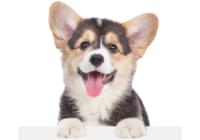What are the symptoms?
In puppies with a retained deciduous tooth, a permanent tooth is seen along side the baby tooth it was meant to replace. The permanent canine teeth usually erupt in front of the deciduous canines.
What are the risks?
Retained baby teeth frequently cause a crowding of the teeth along the gum line. This crowding displaces the permanent teeth so that they are out of line or grow at odd angles. The abnormal placement of teeth can interfere with the normal growth and development of bones in the jaws. They may contact the roof of the mouth causing injury and pain. Retained teeth may also die and abscess, causing mouth infections to develop.
What is the management?
Retained deciduous teeth should be extracted. This will usually require anesthesia and surgical extraction. Check a puppy's mouth weekly until about seven months of age for abnormal teeth. Consult a veterinarian for an oral examination if any retained teeth are suspected.
Resources:
Veterinary Partner: Retained baby teeth






